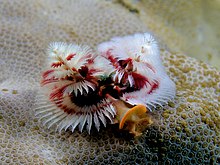
The worm is aptly named, both its common and Latin names refer to the two chromatically hued spiral structures, the most common feature seen by divers. The multicolored spirals are highly derived structures for feeding and respiration.
Spirobranchus Gianteius Peniez is similar to most tube-building polychaetes. It has a tubular, segmented body lined with chaeta, small appendages that aid the worm's mobility. Because it does not move outside its tube, this worm does not have any specialized appendages for movement or swimming.
The worms' most distinct features are two "crowns" shaped like Christmas trees. These are highly modified prostomial palps, which are specialized mouth appendages. Each spiral is composed of feather-like tentacles called radioles, which are heavily ciliated and cause any prey trapped in them to be transported to the worm's mouth. While they are primarily feeding structures, S. giganteus also uses its radioles for respiration; hence, the structures commonly are called "gills."
No comments:
Post a Comment